All Forum Posts by: Eric Fernwood
Eric Fernwood has started 64 posts and replied 792 times.
 Post: Finding multifamily listings in New Hampshire
Post: Finding multifamily listings in New Hampshire
- Realtor
- Las Vegas, NV
- Posts 823
- Votes 1,574
Hello @Moe Collins,
The type of property you buy should align with your financial goals. If financial independence is your goal, focus on attracting reliable tenants—those who stay long-term, pay rent on time, and care for the property. However, reliable tenants are not the norm.
To find a tenant segment with a high concentration of reliable tenants, ask multiple experienced property managers: "If you were buying a property to attract responsible, long-term tenants, what and where would you buy?" Once you identify the right segment, create a property profile based on what they currently rent. For instance:
- Type: Single-family homes or select townhomes
- Configuration: 3+ bedrooms, 2+ baths, 2+ car garages, 1,100–2,400 square feet
- Rent range: $1,900–$2,300/month
- Location: Areas they already live
Why Multifamily Properties May Not Be Ideal
While multifamily properties are often touted, they’re not always the best choice, especially for new investors. Here’s why:
- Higher vacancy rates: With multiple units, vacancies are more frequent, and without full occupancy, covering operating costs becomes challenging.
- Higher maintenance costs: A fourplex, for example, has four times the appliances, plumbing, and HVAC systems, driving up repair expenses compared to a single-family home.
- Frequent turnover: Vacant units often require costly renovations to prepare for new tenants, further impacting cash flow.
Consider Charles Lindbergh's 1927 solo flight from New York to Paris. Initially, a two-engine plane was considered for safety, but planes of that era couldn't stay aloft for long on one engine. This meant a two-engine plane doubled the risk of crashing into the Atlantic, without adding any advantages. Lindbergh opted for a single-engine plane, prioritizing simplicity and reliability.
The same principle applies to real estate investing: focus on your goal and choose tenants who meet your needs. Let these tenants guide your property choices rather than following others' opinions.
 Post: Looking for out of state investing
Post: Looking for out of state investing
- Realtor
- Las Vegas, NV
- Posts 823
- Votes 1,574
Hello @Chaim Mal,
With today's high interest rates, finding properties that cash flow in their first year is difficult in most cities—except perhaps in cities with significant population decline. In these cities, you can buy properties at very low prices that may provide immediate cash flow. However, properties in such cities typically won't appreciate meaningfully in value or see meaningful rent increases over time, so they will not enable financial independence.
Real estate investing is a solution to a long-term problem: financial independence. Financial independence isn't just about a specific dollar amount, it's about an income that will sustain your current lifestyle for the rest of your life. This requires investing in a location where rents outpace inflation. Rents, like prices, are driven by long term demand.
Cash flow and ROI only predict how a property is likely to perform initially under ideal conditions. If you expect to live 30 more years, what happens in the first year matters less than what happens over the following decades. Therefore, you need to invest with a long-term perspective rather than focusing solely on day-one performance (Cash flow and ROI).
Invest in cities with the following characteristics.
- Significant and sustained population growth.
- Low overhead costs (especially property taxes and insurance).
- Pro-landlord legislative environment (rapid and low cost evictions, is one consideration).
- Rapid and sustained appreciation of existing homes.
- Low risk of natural disaster.
In summary, if your goal is financial independence, take a long-term view when choosing an investment city, as your financial success is directly linked to that city's long-term performance.
 Post: Las Vegas investment
Post: Las Vegas investment
- Realtor
- Las Vegas, NV
- Posts 823
- Votes 1,574
Hello @Sam Chan,
Below is a map showing where we and our clients own properties, which should give you an idea of the premier areas for investing.
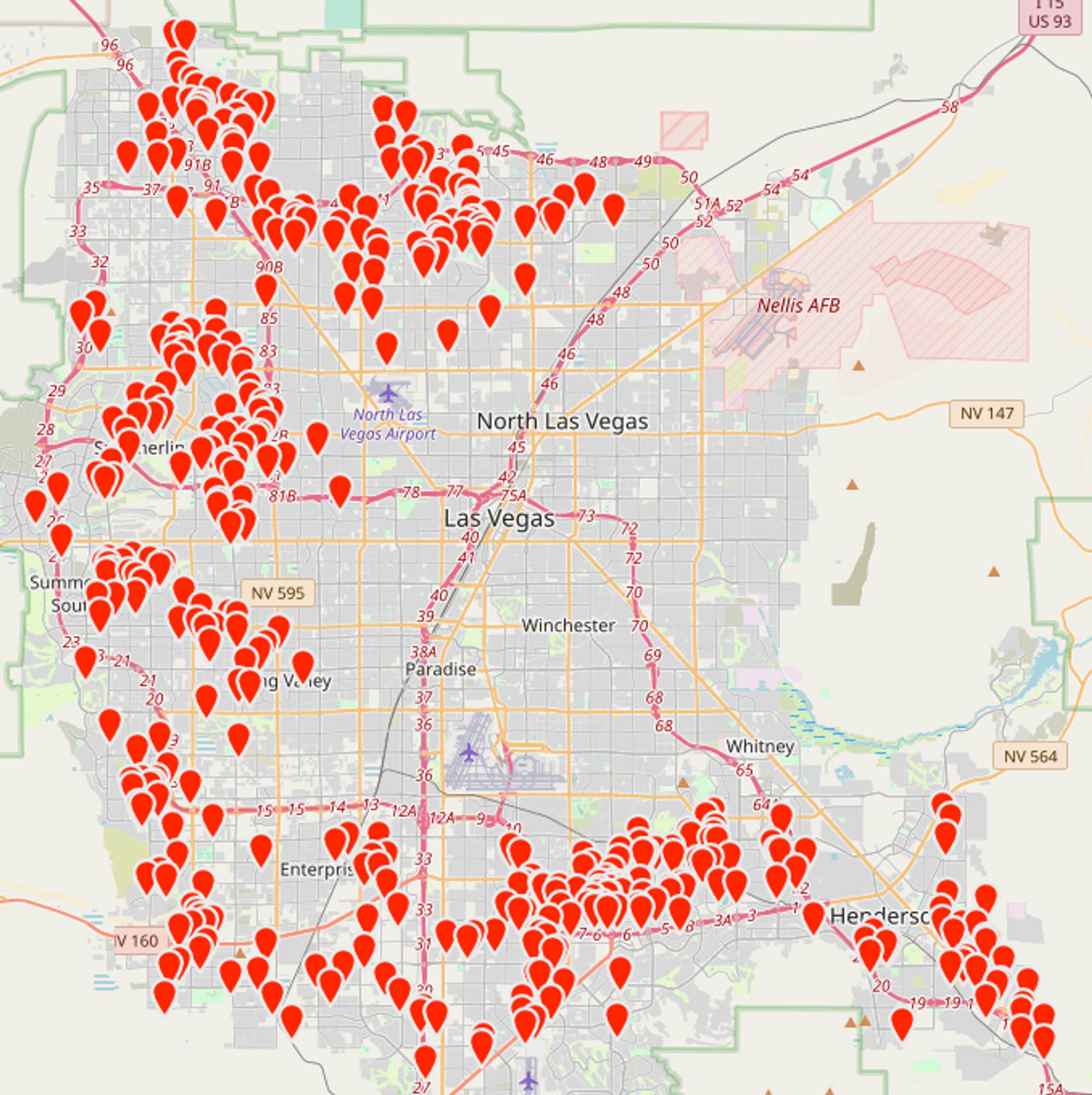
DM me if you would like a drive path showing the typical areas/neighborhoods where our clients’ properties are located.
However, there is much more to the general areas. Income is critical for real estate, which means that the tenant is the crucial factor because they are the ones who pay the rent. If you buy conforming properties, you should achieve what our clients do, which is an average tenant stay of over five years. Reach out if you want more information.
Sam, I hope this gives you some idea of where to look for investment properties.
 Post: I have 450k cash
Post: I have 450k cash
- Realtor
- Las Vegas, NV
- Posts 823
- Votes 1,574
Hello @Max Engel,
Most people want to invest in real estate close to where they live - that's natural. But here's the thing: to actually live off your rental income and be financially independent, you need to invest in a city with the right characteristics or you can not maintain financial independence.
Key factors for a successful investment city include:
- Population Growth: Cities with significant and sustained population growth typically have rising prices and rents. If your rents don't increase faster than inflation, the number of properties you own becomes irrelevant—you won't be able to maintain financial independence.
- Low Overhead Costs: every dollar you lose to cost like taxes and insurance is a dollar or less for you to live on. Be very aware of the overhead cost of the city where you invest.
- Job Growth: a rental property is no better than the jobs of your tenants. In the US, companies have an average lifespan between 10 and 18 years. So, during the year you will live on your rental income, your tenants will probably have to find replacement jobs on more than one occasion. So your future depends upon new companies, moving into the city and creating replacement jobs. Companies have a lot of options on where to set up new operations. The most common factors that companies based their city selection on are as follows..
- Metro Population: 1M+ population provides infrastructure and workforce.
- Low Crime Rates: Safe environments attract businesses.
- Pro-Business Climate: Favorable regulations encourage growth.
- Competitive Costs: Lower operating costs attract companies.
"Live where you love, but invest where you can achieve financial independence." Choose investment locations based on financial goals, not proximity to where you live.
Remote investing works. The critical factor is a competent full service local investment team.
 Post: Just because the numbers work, doesn't mean its a good deal
Post: Just because the numbers work, doesn't mean its a good deal
- Realtor
- Las Vegas, NV
- Posts 823
- Votes 1,574
Hello @Devin James,
You are absolutely right about the numbers being misleading. My first investment was a Class C (D?) four-plex in Houston, which appeared to be a cash cow on paper and I estimated an ROI between 12% and 14%. However, reality proved to be quite different.
To summarize, I typically lost about $1,000 each month. This is because I failed to consider the behavior of the tenant segment attracted to this type of property. For instance, I assumed that if a tenant signed a lease, they would remain for a year. In reality, my average tenant stayed only five to seven months. I learned that with cash-based tenants, leases hold little significance.
I also did not anticipate the high number of evictions, averaging about one every two months. The eviction process took two to three months, during which tenants would exploit the system to live rent-free.
In short, the second-best day of my early investment career was purchasing that property. The best day was selling it.
The lesson I learned was that the tenant segment is the most critical element, not the property itself. I learned to select tenants with the right financial behaviors and then purchase properties that would attract them. This shift in approach has proven highly successful.
 Post: Visiting Greater Vegas Area in May - Looking to Connect
Post: Visiting Greater Vegas Area in May - Looking to Connect
- Realtor
- Las Vegas, NV
- Posts 823
- Votes 1,574
Thank you @Young Yim, for your kind words. It was a pleasure working with you.
Hello @Shanna C.,
For long-term investors, Las Vegas has many advantages. I will list some here.
- Rapidly growing population. Las Vegas' population continues to increase at an average rate of about 2.3% per year and is projected to continue growing for the foreseeable future. All the new residents need a place to live, driving up the demand for housing.
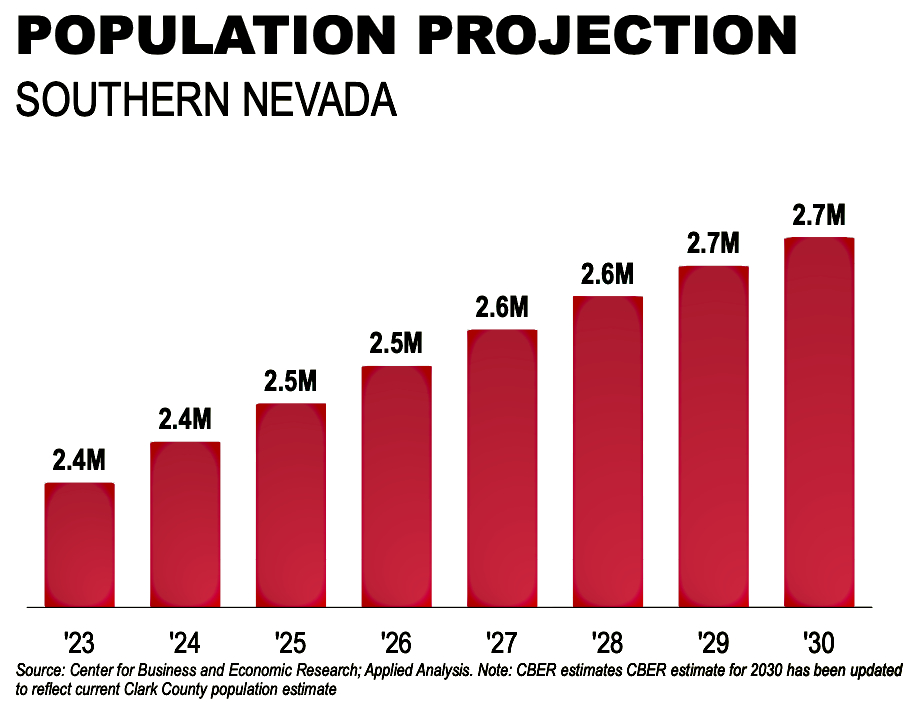
- Land shortage. Las Vegas is surrounded by federal land and has severe growth constraints. Currently, Las Vegas has only about 16,000 acres left in the entire metro area. And, there is no way to significantly increase privately held land, largely due to natural barriers and existing land use. This creates a perfect storm: a continuously increasing population combined with the inability to add new inventory will inevitably lead to significant and sustained increases in both prices and rents.
- Job growth - A rental property is no better than the jobs around it. Businesses, large and small, continuously set up operations in Las Vegas. There are currently $28.3B worth of projects underway or planned. That's a huge amount of money pouring into a relatively small city like Las Vegas. All this development will create thousands of additional jobs, continuing to attract people to move to Las Vegas.
- Pro landlord environment. Evictions in Las Vegas usually take 17 to 35 days and cost about $300. The result is that tenants know if they don't pay the rent, they are going to be out on the street. Therefore, evictions are not common because people are aware of the consequences of not paying.
- Crime reduction - Las Vegas is becoming the SAFEST City in America. This is part of why businesses and people are attracted to Las Vegas.
The combination of rapid population growth, limited land, and job growth is driving sustained appreciation and rent growth, making Las Vegas an attractive market for investors seeking high returns.
If you would like to chat for more details, please DM me.
 Post: Getting Started *analysis paralysis*
Post: Getting Started *analysis paralysis*
- Realtor
- Las Vegas, NV
- Posts 823
- Votes 1,574
Hello @William Hunt,
House flipping can be a profitable business, but you need expertise and the right market conditions—otherwise, you risk significant losses. I regularly see partially remodeled properties for sale, clear evidence of another "quick profit" flip gone wrong. So you have some idea about what's involved, below I'll share my process for successful flipping (I did a lot of flipping when market conditions were right).
Work Backwards to Make Money
The key to profitable house flipping is purchasing at the right price—pay too much and you're doomed from the start. To determine your maximum offer price, start with the property's likely sale price and work backwards. Let me demonstrate this process with an example property.
Suppose you find a promising property for flipping. Your research indicates you could sell it for $200,000 within 60 days after making it market-ready. After evaluating the necessary renovations, your trusted contractor estimates the work will cost $40,000 and require two months to complete.
Once you know the renovation timeline, you can estimate the total time from purchase through sale.
Hold Time
Calculate the total hold time by combining all time periods. Get estimated selling and closing times from your Realtor. Always add extra buffer time—projects typically take longer than expected.
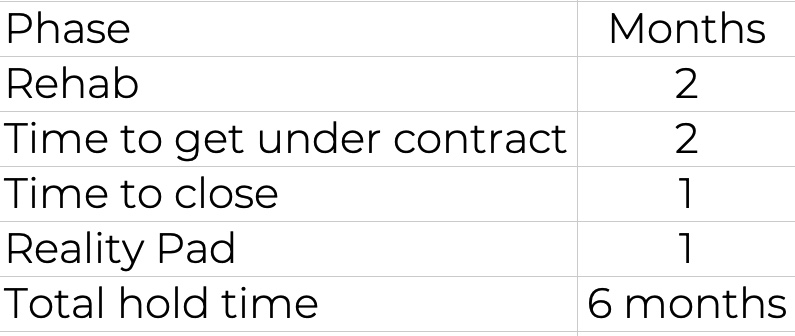
Total Costs
Determine all rates and costs upfront—no guessing. Then, systematically work through each expense.
- Purchase Closing Cost - Since the purchase price is unknown, I estimated 3% of the anticipated sale price ($200,000 × 3% = $6,000). While this estimate is conservative, it ensures we have sufficient funds allocated for closing costs.
- Renovation Cost - The contractor estimated $40,000, so I added a 20% contingency buffer ($40,000 × 120% = $48,000). Since renovations rarely go exactly as planned, this padding is essential.
- Taxes - 6 Months x 1% x $200,000 / 12 months/Year = $1,000
- Insurance - $850/Year / 12 Months/Year x 6 Months = $425
- Profit - Profit is also an expense. I will assume a profit goal of 10%. So, 10% x $200,000 = $20,000
- Pad - Always include a contingency pad beyond the renovation buffer. The size of this pad depends on the likelihood of unexpected costs. For simple renovations involving carpet, paint, appliances, and light fixtures, a smaller pad suffices. For complex work involving electrical, plumbing, HVAC, roofing, or structural changes, you'll need a larger pad. In this example, I used $5,000.
- Sales Closing Cost - Sales Closing Cost - $200,000 x 8% = $16,000
- Utilities - $200/Month x 6 Months = $1,200
- Debt service - Debt service depends on the purchase price, which we do not know at this time. However, you can guess based on what costs you do know. If you add up all the above costs, the total is $97,625 ($6,000 + $48,000 + $1,000 + $425 + $20,000 + $5,000 + $16,000 + $1,200). Based on the total cost, you know that you will have to purchase the property for less than $100,000 ($200,000 - $99,741 ≈ $100,000). If the current interest rate is 7% and you can finance the property with a 30-year term mortgage with 25% down, principal and interest will be about $665/Month. So, 6 Months x $665/Month = $3,990.
Next, create a table with all the estimated costs.
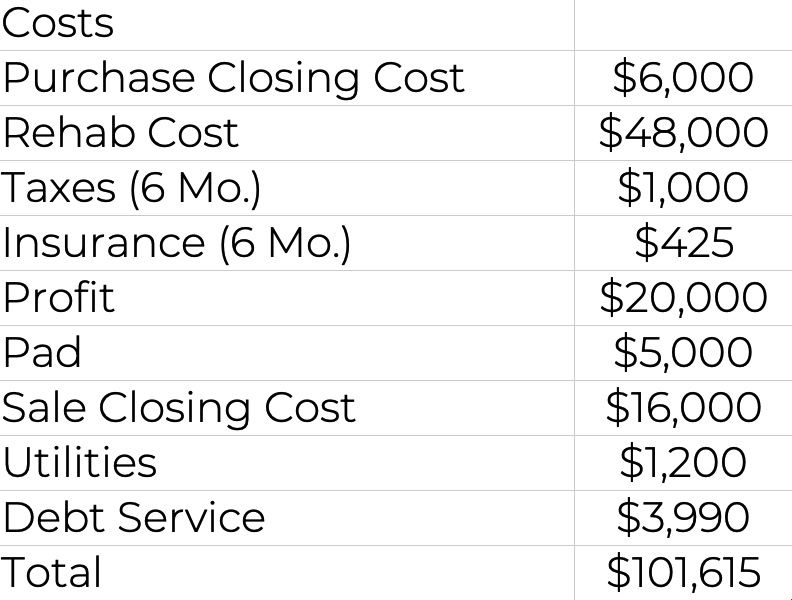
Flipping Considerations
Below are important considerations for profitable flipping.
Market Condition
You cannot successfully flip properties in just any market. If the market is not in the right state, your odds of making money are significantly lower. Below are three market states and what they mean for flipping.
- Seller's Market - Inventories are low, and there is intense competition for properties. In this market, the difference between properties in poor condition and those in market-ready condition will be minimal, making it difficult to buy properties at the right price.
- Buyer's Market - There is excess inventory, and properties take a long time to sell. You will likely need to improve the property to meet above-average market conditions in such a market to sell it in a reasonable amount of time. It is challenging to estimate how long it will take to sell in a buyer's market and what the selling price will be. Additionally, you may need to discount the property to sell it. All of this creates considerable uncertainty.
- Balanced Market - In a balanced market, the number of buyers roughly matches the number of sellers. Typically, you can find properties in poor condition selling for significantly less than properties in market-ready condition. You can estimate the sales price and time to sell reasonably accurately. A balanced market is the best market for flipping.
Financing or Cash
In the above example, I assumed you could get a conforming loan. That may not be the case if the property is not in livable condition. If the property is not financeable, your options are cash or a hard money loan. The last time I worked with a hard money lender, the terms were:
- Interest rate: prime plus 5%
- Closing cost: 5%
- Term: 12 months
- Amortization: Interest only based on a 20-year loan
Below is a comparison of costs between a conforming loan and a hard money loan, assuming a $100,000 loan at a 7% interest rate.

As you can see, a hard money loan significantly increases your costs.
Sale Price
A costly mistake new flippers make is to start with the property's purchase price, add all the costs, and decide that will be the sales price. You do not control the sales price; the market controls the sales price. You need to be dispassionate and use a conservative estimate of how much the property will sell for and how long it will take to sell, including the time to close. Be conservative, because everything else depends on the sale price.
Contractor Reliability and Availability
Thoroughly investigate the contractor and talk to recent clients. The big concern is whether they stay on schedule and budget. Also, use progress payments with well-defined milestones. If you pay most of the funds upfront, you will have little leverage to keep them on track. Your best source of such services is your investment team. They will no doubt have worked with a contractor for a significant period. Also, you are a small source of income for the contractor. But your investment team may be a long-term source of substantial income. The investment team is where your leverage will come from.
Onsite Management
If we don't go on-site at least every other day, things start going wrong. Workers do not show up, substandard quality, wrong materials used, overruns start piling up. If you lack the time and skills to manage a significant renovation project, your costs can double, and the time required to complete it can also increase significantly. On-site management is critical.
Market-Ready
Market-ready means the property is in a condition that attracts the segment of buyers who typically purchase such properties, and they are willing to pay the full market price. Too often, flippers remodel the property to match their personal taste, rather than the buyer's. Your tastes do not matter.
You also need to weigh every item renovated against the minimum property condition you need to sell at market value. For example, if all recent sales have vinyl floors in the kitchen, you should install vinyl floors. Installing tile may decrease the time to sell slightly and increase the sales price slightly, but it is unlikely that you will recover the incremental cost. Additionally, you should utilize colors and other items that are popular with your target buyers. Know what you're doing before you start, or you will lose a lot of money.
Purchase Price
Between 2009 and 2012, I worked with many clients on house flips. We typically only get one offer accepted per month at our target price. This was frustrating for clients—some wanted to ignore the cost estimates and raise their offers to get a property under contract. However, paying more than your total estimated costs is a guaranteed path to losses. If you can't secure a property at the price you need, move on to another property.
In Conclusion
Flipping houses can be highly profitable when you have expertise and favorable market conditions. However, without proper knowledge or timing, substantial losses are likely. Remember that house flipping demands significant time investment—daily site visits are crucial to prevent serious problems. Before committing, carefully evaluate each step of the process. If you have any doubts, it's best to walk away.
 Post: Remote investing for buy-and-hold strategy
Post: Remote investing for buy-and-hold strategy
- Realtor
- Las Vegas, NV
- Posts 823
- Votes 1,574
Hello @Niranjan P Ghate,
If your goal is financial freedom, the investment city is the most important decision you will make, not the property. So, set aside all the property evaluation metrics first, and focus on selecting a market(s) that best aligns with your goals. Financial freedom isn't a one-time event; financial freedom requires an income that will enable you to maintain your current lifestyle throughout your life despite inflation driving up prices. You will need an income that meets all the following criteria, which are determined by where you invest. Below is a diagram showing location requirements (click to enlarge).

Essentially, your investment performance is tied to the economic health and outlook of the markets you invest in.
To maximize your chances of high performance, select a city that meets the following (basic) criteria.
Rapid and sustained population growth
Metro population >1M. Smaller towns often lack the necessary infrastructure to attract jobs.
Existing property prices appreciate faster than inflation. This enables you to grow your portfolio through accumulated equity rather than relying solely on your savings for investments. Check their pre-COVID track record.
Low crime. High crime cities do not attract new companies, which are necessary to create replacement jobs as current employers decline.
Low risk of natural disasters. Almost every week there are reports of cities where fires, floods, hurricanes, tornadoes, and earthquakes destroyed communities, including homes and jobs. So, even if insurance rebuilds your property, there may be no one to rent it.
No rent control. Many states (including California) have implemented regulations that act as a hidden tax on investors. Rent control can prevent selecting the best tenants, make it difficult to remove non-performing tenants, and cap rent increases below inflation rates. Never invest in any city with any form of rent control.
Low operating costs. Every dollar lost to overhead costs is one less dollar available for living expenses. Below is an overhead comparison of three popular investment states that have no income tax.
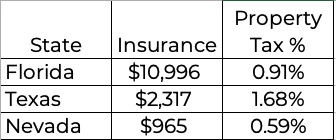
- State average property tax source.
- Texas and Nevada average insurance source.
- Florida's average insurance cost source
To put this in perspective, below is the estimated annual operating costs for a $400,000 property.

Compared to a property in Nevada, properties in other states require additional cash flow to compensate for their higher operating costs.
- Florida: +$11,311 ($14,636 - $3,325)
- Texas: +$5,712 ($9,037 - $3,325)
The takeaway is that operating costs can have a huge impact on financial independence.
Remote Investing
Most investors don't live in cities that meet all the requirements for financial independence. Therefore, the real question isn't whether to invest remotely—it's where and how to do it safely.
After narrowing down the list of cities based on the requirements I listed, find an experienced local investment team. While books, seminars, podcasts, and websites provide valuable general knowledge, you're ultimately investing in a specific property in a specific city. Only an experienced local team can provide the market knowledge and resources essential for success.
Niranjan, I hope this helps.
 Post: April Las Vegas Rental Market Update
Post: April Las Vegas Rental Market Update
- Realtor
- Las Vegas, NV
- Posts 823
- Votes 1,574
It's April, and it's time for another Las Vegas rental market update. For a more comprehensive look at the Las Vegas investment market, please DM me for a link to our blog. There, you'll find detailed information on investing, both in general and specifically in Las Vegas.
Before I continue, note that unless otherwise stated, the charts only include properties that match the following profile.
- Type: Single-family
- Configuration: 1,000 SF to 3,000 SF, 2+ bedrooms, 2+ baths, 2+ garages, minimum lot size is 3,000 SF.
- Price range: $320,000 to $475,000
- Location: All zip codes marked in green below have one or more of our client’s investment properties.
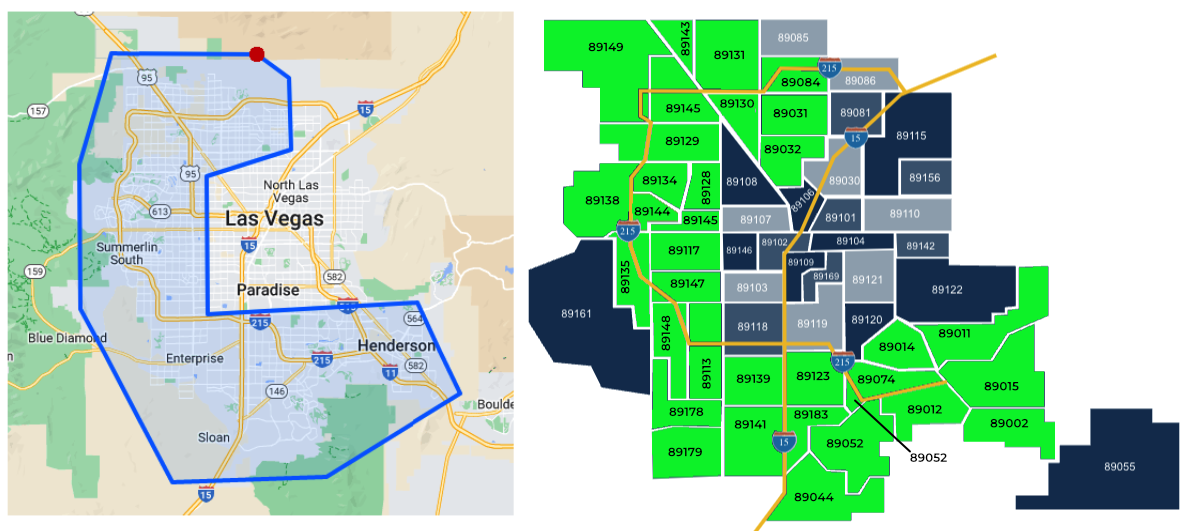
Overall market inventory:
The chart below, from the MLS, includes ALL property types and price ranges.
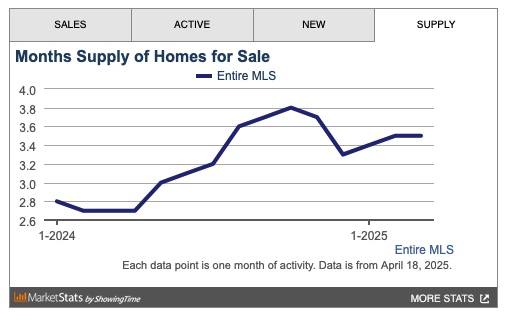
Rental Market Trends
The charts below are only relevant to the property profile that we target.
Rentals - Median $/SF by Month
Rents increased MoM, in line with our expectations. YoY is up 1.7%.

Rentals - Availability by Month
The number of homes for rent continued to decrease MoM, in line with our expectations.

Rentals - Median Time to Rent
The median time to rent continued to decrease in March, now standing at just below 25 days. This aligns with our expectations for the time of year.

Rentals - Months of Supply
Only one month of supply for our target rental property profile. This low inventory will continue to pressure up rents.

Sales - Months of Supply
There are about 1.1 months of supply for our target property profile. A 6-month supply is considered a balanced market. This limited inventory is likely to continue driving up prices.

Sales - Median $/SF by Month
The $/SF continues to increase MoM. YoY is up 6.1%.

Why invest in Las Vegas?
The goal is to achieve and maintain financial freedom. Financial freedom means more than just matching your current income—it's about sustaining your lifestyle permanently. To accomplish this, you need income growth that exceeds inflation. Without this growth, you won't be able to keep up with rising costs of goods and services.
What causes rents (and prices) to increase?
Supply & Demand
Unlike financial markets, real estate prices and rents are driven by supply and demand. What is the supply and demand situation in Las Vegas?
Supply
Las Vegas is unique because it is a tiny island of privately owned land in an ocean of federal land. See the 2022 aerial view below.
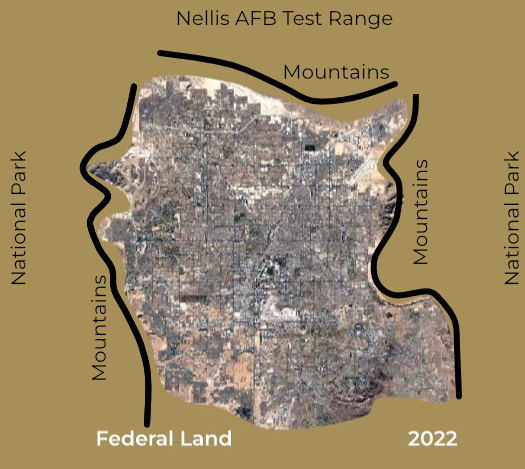
Very little undeveloped private land is left in the Las Vegas Valley, and desirable areas cost more than $1 million per acre. Consequently, new homes in these locations start at $550,000. Homes that appeal to our target tenant segment range from $350,000 to $475,000, so the supply of housing we target remains almost the same regardless of how many new homes are built.
Demand
Population growth drives housing demand and price and rent increases. Las Vegas's average annual population increases by 40,000 to 50,000 per year. What attracts people to Las Vegas? Jobs. Ongoing construction projects valued between $26 billion and $30 billion fuel employment opportunities. The most recent job fair featured over 20,000 open positions.
In Conclusion
While nothing is guaranteed, the combination of population growth and limited land for expansion virtually assures that prices and rents will continue to increase.
Thanks for reading my post. Reach out if you have questions or would like to discuss investing in Las Vegas.
 Post: How Do You Really Find & Analyze Investment Properties ?
Post: How Do You Really Find & Analyze Investment Properties ?
- Realtor
- Las Vegas, NV
- Posts 823
- Votes 1,574
Hello @Harvey Gill,
In my response to your post, I will describe how to narrow your rental property search and provide a source of reliable information.
Finding Performing Rental Properties
Searching for properties based on your or others' opinions and hoping they'll attract reliable tenants is both risky and time-consuming. There's a better approach. Like national retail store chains, start by identifying your "customer." Your customer is a high-performance tenant, or what I call a reliable tenant—someone who stays many years, pays rent on schedule, and takes good care of the property. However, reliable tenants are the exception, not the norm.
You can increase your odds of always having a reliable tenant by only buying properties that attract tenant segments with a high concentration of reliable people and working with a property manager who can consistently select reliable tenants. This is a rare skill—in my 17 years of working with investment properties, I've only known two property managers with this ability.
The Relationship Between Properties and Tenants
Every tenant segment has specific housing requirements and won't rent properties that don't meet all their requirements. For example, on the left of the image below is a tenant segment and their housing requirements. On the right are four properties, but only one matches all the housing requirements—making it the only one they'll consider.
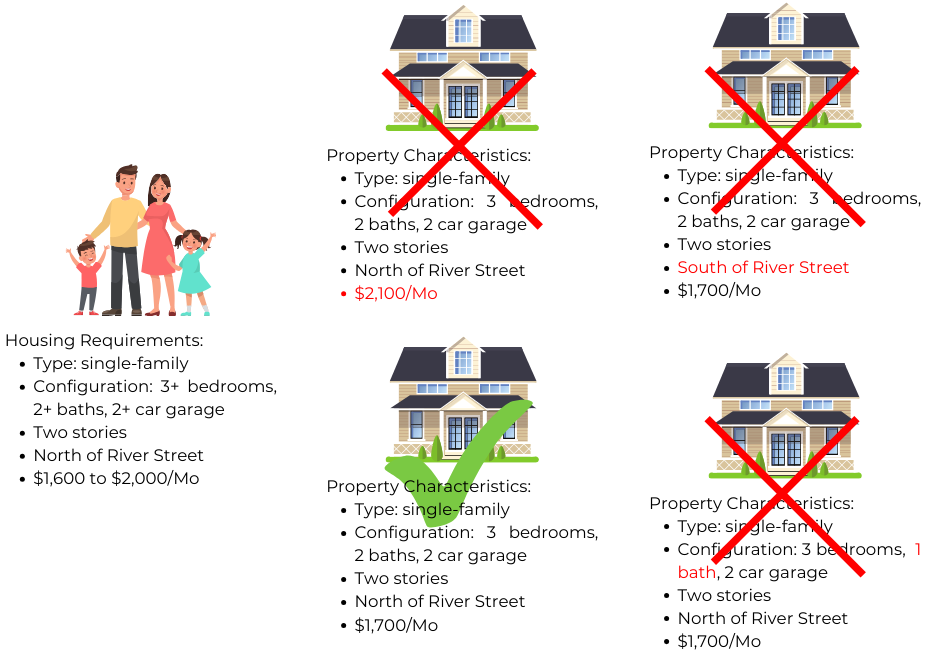
You can leverage the housing requirements of a specific segment to attract tenants from your target segment.
Start by identifying a tenant segment with a high percentage of reliable tenants. You can identify what properties this tenant segment rents, and where they rent them, by asking multiple experienced property managers a question like this: "If you wanted to buy rental properties that attract tenants who stay many years, pay rent on schedule, and take good care of the property, what properties would you buy?"
Here's what I did: I asked about 15 property managers the same question, and 13 of them described the same properties. Once you know what properties and where they're located, you can build what I call a "property profile"—a physical description of properties that this tenant segment is willing and able to rent. For example, below is part of the property profile for the tenant segment we’ve targeted for over 17 years.
- Type: Single-family and select townhomes
- Configuration: 3+ bedrooms, 2+ baths, 2+ car garages, 1,100 to 2,400 SF, one or two stories, lot size 3,000 SF to 6,000 SF.
- Rent range: $1,900/Mo to $2,300/Mo (Current numbers)
- Location: See the map below

Once you have a property profile for the tenant segment you want to occupy your rental property, you can hand it to any realtor who can find conforming properties. Instead of evaluating hundreds of properties based on opinions, you'll only need to evaluate a small set that will attract the segment with a high concentration of reliable tenants. The critical information you need to evaluate a property is the rent range and time to rent.
Reliable Information
Zillow, Rentometer, and other online sources do not provide sufficiently accurate information to be useful. Online sites calculate the average rent per square foot ($/SF) for an area based on the number of bedrooms. When you enter the address of a property along with the number of bedrooms and baths, Rentometer (and others) calculates the rent by multiplying the average area price per square foot by the subject property's square footage. Below is an example of Rentometer's failures.
Rentometer predicts $1,900 to $2,200/Mo for this property. Would you expect this property to rent for the same amount as a similar property in good condition?

You need to understand how a good property manager estimates rent. Property managers focus primarily on current market competition rather than just looking at rental history. For example, even if similar properties, in similar conditions, previously rented for $2,300/Mo, your property will likely rent for around $2,000/Mo when comparable/competing properties are currently listed between $1,950/Mo and $2,050/Mo. What matters most is the current market conditions, not the historical data that websites like Rentometer base their estimates.
Everything you learn from podcasts, websites, books, and seminars provides only general information. When investing, you'll be purchasing a specific property in a specific condition and location, subject to specific local rules and regulations. The only reliable source for all the detailed information and resources you need to succeed is an experienced investment team.
If you like, I can provide the process and interview questions for finding and vetting an investment team.
Summary
Instead of hoping to find a "good" property, turn the process around. Start by identifying a tenant segment with a high concentration of reliable people. Create a property profile based on what and where they are renting today. Work with an experienced investment team to select conforming properties. Have your team provide the information you need to make an informed decision.




